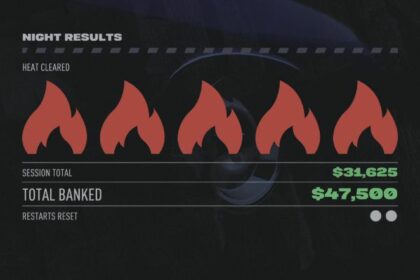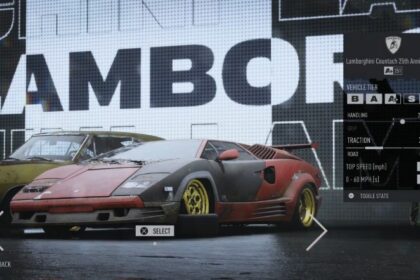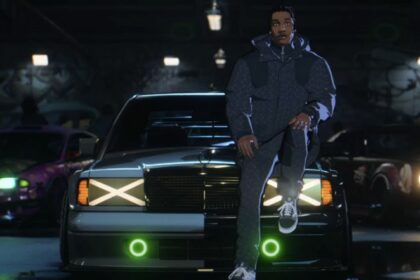With the Need For Speed series adopting the class system made famous by games like Forza Motorsport, tuning has become a bit more prevalent and important in Need For Speed Unbound.
Although these tuning options were present in older Need For Speed titles (Need For Speed Underground 2 had a dyno system and Need For Speed Prostreet had a wind tunnel!), they were not exactly something you would want to spend time in since you could always just put in the best performance upgrades on your car and you could beat the game relatively easily.
Now with online play, every little advantage is magnified. Not to mention that the tuning options here also allow you to either build up a primarily drifty car or a primarily grippy car, giving you the option to either make a sideways demon or an apex killer.
In this NFS Unbound tuning guide, we will be going through the best tuning setups in Need For Speed Unbound and figure out which performance upgrades are worth it on all class levels.
We will also be looking at which performance upgrades would help most in each racing discipline that you will be tackling throughout your single player career or your online career.
How to Unlock Tuning
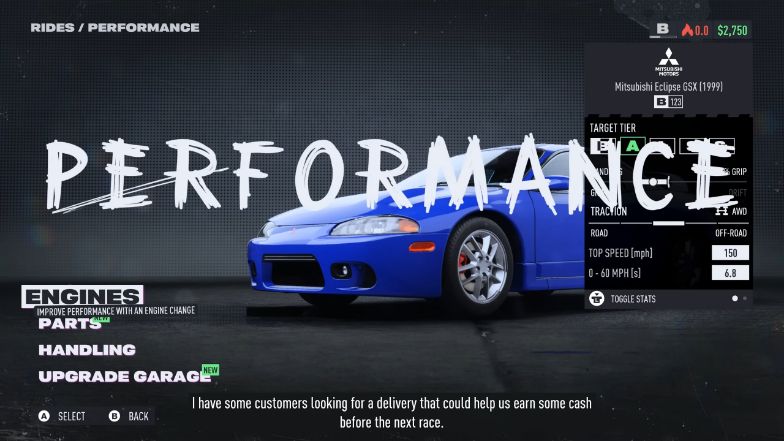
In order to unlock the performance tuning for your offline garage, you must first finish the prologue of the game. This will also unlock the handling tuning menu. So the way your car handles in the prologue depends solely on which prologue starter car you chose.
You will only be able to change the handling tuning and do performance tuning once you have chosen your real starter car for the offline portion of the game.
As for online mode, the performance tuning and handling tuning will be available right at the start once you have chosen your online starter car as you are thrown right into the action for online racing.
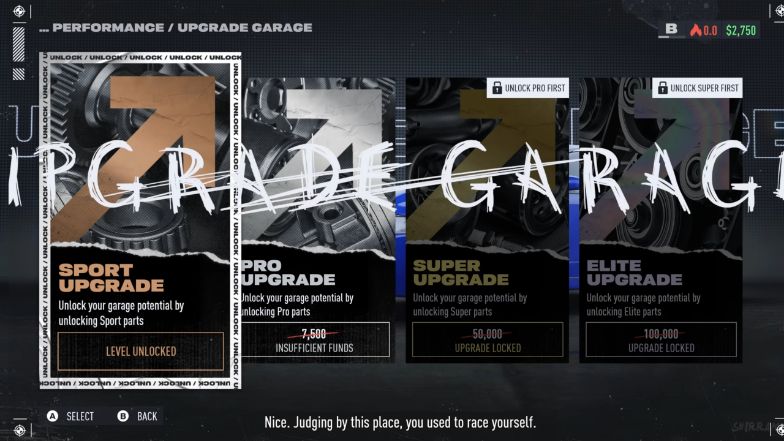
You will also need to upgrade your garage to unlock better performance parts, and this will cost you a lot of money. In order to unlock Pro tier upgrades, you will have to spend $7,500, for Super tier upgrades it will be $50,000, and finally, for Elite tier upgrades, you will need a whopping $100,000.
You also can not jump upgrade tiers. So in order to unlock the Elite tier, you will have to buy both Pro and Super tier upgrades before you can buy the Elite tier ones.
Since progress for online and offline is separate, you will have to do this separately as well so unlocking a garage upgrade for one mode will not unlock it for the other. You will have to earn a lot of money just to get the best parts for your car.
How to Tune Your Car
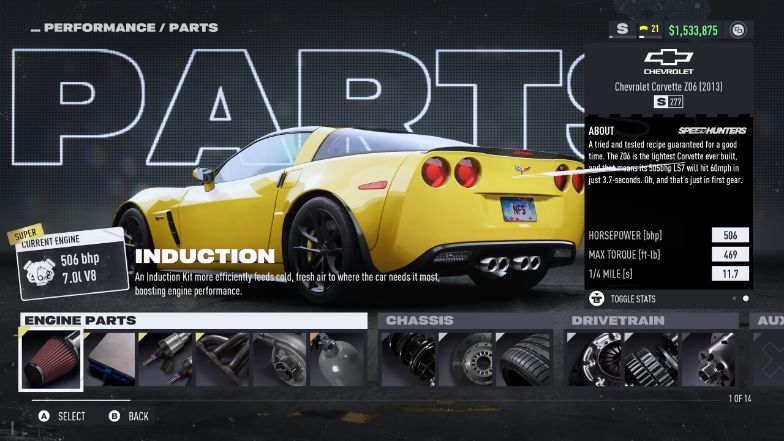
The tuning in Need For Speed Unbound is pretty simple really as it is mainly divided into two groups: performance tuning and handling tuning.
Performance Tuning
Performance tuning is where you basically install performance upgrades to your car and depending on what you install, will make your car faster or more suitable to your liking.
Not much nuance can be placed in this part of tuning as you can pretty much min-max your stats by installing parts at your leisure and checking your performance rating from time to time, making sure not to go over your target class rating.
Take note however that you can not sell parts that you have bought, so you should crunch the numbers first before making that purchase as money is pretty hard to come by in Need For Speed Unbound, especially in the early game.
They are also simple enough to understand. The better the parts, the more performance rating you get. This is especially true for parts like the Induction, ECU, Fuel System, Exhaust, Nitrous, Brakes, Clutch, and Differential.
These parts basically have only one option per garage upgrade tier. So the better the tier, the more they give. For Engine Parts like the Induction, ECU, Fuel System, and Exhaust, the more expensive the part, the more horsepower and performance rating it will give.

For example, installing the Elite ECU for $42,500 will always yield better power gains than installing an Elite Fuel System which only costs $27,500.
For Nitrous, the better the tier, the longer your nitrous will last. For the Brakes, the better the tier, the better your brakes will work. This is especially important with older cars as they will have worse stock brakes than your average supercar or sports car.
The same can be said for the Clutch, but this part also doubles as a crucial part to upgrade for drift and drag builds as well as older cars as they will need the faster acceleration to row through the gears much more smoothly.
Lastly, there are the Differential upgrades. The better the differential you put in your car, the bigger the area of customization you can play with in the handling tuning’s handling slider.
However, there are some parts that are worth it to go over as they offer a bit of variety under their selections. Below will be a list of performance tuning parts that have a bit more options under their respective tiers and will need a bit of consideration on what to get for what build you are aiming for.
Engine Swaps

The most varied performance option in the game, engine swaps open up a portal of possibilities when tuning your car. Every individual car will have its own list of engines that it can swap with. Sometimes they will have a lot, and sometimes they will have none.
By changing the engine of your car, not only will you be changing the potential power gains of your car, but you will also be changing the sound it produces, so if you are a fan of the rumbles of a V8 or the shrieks of a V12, you can definitely do it here.
Take note as well of the Potential values of the engine that you will be swapping with. It is entirely possible that you could be swapping your stock engine out for something worse, however, this could definitely be used as a way to get a car under its current class rating.
Take for example this 2013 Chevrolet Corvette Z06. By swapping out its stock LS7 for a 2019 BMW M2 Competition’s S55 engine, it can lower its class rating from S to A+. However, it is also good to note that the S55 has better power potential than the LS7 despite the lower stock horsepower rating.
The only thing that is really stopping you from an engine swap is the ridiculous prices they command. The cheapest engine swaps can go for upwards of $24,000 and the most expensive ones will cost you $400,000.
So yes, they are a hefty investment, but it is all in the name of speed, right?
Forced Induction
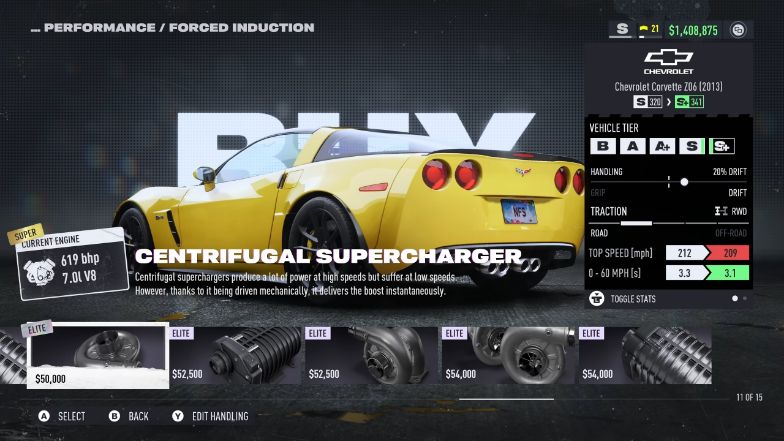
There is quite a number of forced induction kits available in Need For Speed Unbound, namely: the Centrifugal Supercharger, Screw Supercharger, Turbo Charger (or Single Turbo Charger), Dual Turbo Charger (or Twin Turbo Charger), and Roots Supercharger.
Most of the time, we will want to avoid the Centrifugal Supercharger and Screw Supercharger options as these two options do not really offer much in terms of what they are set out to do.
If you are going for a car that would need better acceleration, you can choose between the Roots Supercharger and the Dual Turbo Charger as both offer amazing acceleration and better power figures than both the Centrifugal Supercharger and Screw Supercharger.
This also means that the Roots Supercharger and the Dual Turbo Charger are great options for a drift build and a short-distance drag build as they provide great power as well as the best acceleration.
That leaves us with the Single Turbo Charger. This forced induction option is solely used for long-distance drag builds and speed builds as it will provide the biggest boost as well as the highest top speed. It is, however, the forced induction with the worst acceleration stat, but that does not really matter when you are spending most of your time upwards of 200 MPH.
Suspension
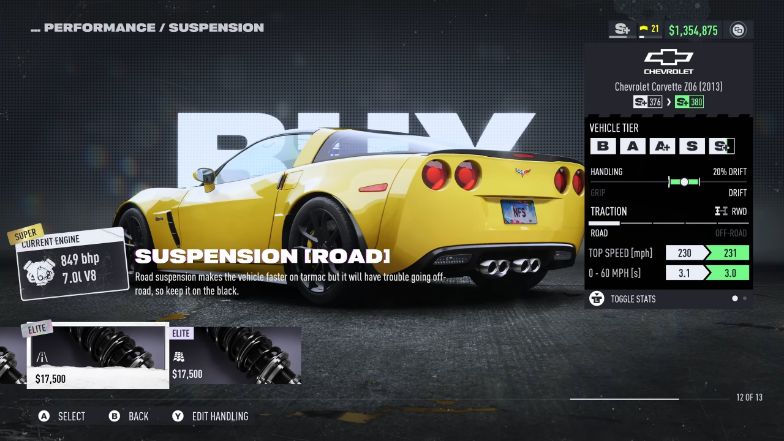
Another performance upgrade with multiple choices per upgrade tier, the suspension upgrades have three different types, namely: Neutral Suspension, Road Suspension, and Off-Road Suspension.
Right off the bat, I will say that equipping Off-Road Suspension is pretty much a waste as most of the tracks you will be racing in will have little-to-no dirt racing on them. The tracks that will have more dirt racing on them, you can infinitely offset these with the Neutral and Road Suspensions.
However, there are some cases that the Off-Road Suspension could be used to lower a car’s performance rating. This is especially true for low-slung sports cars, supercars, and hypercars where you could equip it together with a worse engine just to let it go down a class.
Just take note that doing so will definitely upset the handling characteristics of the car quite a bit, so take a bit of caution when going for a speed build with otherwise softer suspension as it will lead to wayward handling.
The Neutral Suspension option is a great choice if you need a bit more customization on your handling slider. This is also a great option as it adds little-to-no performance rating, so it makes for a great min-max upgrade.
Road Suspension can be used if you have no upgrades left to buy but just want to increase the capability of your car even more. It also adds a bit more customization to the handling slider so if you want to get out just a bit more drift or grip characteristics, this is the suspension for you.
Tires
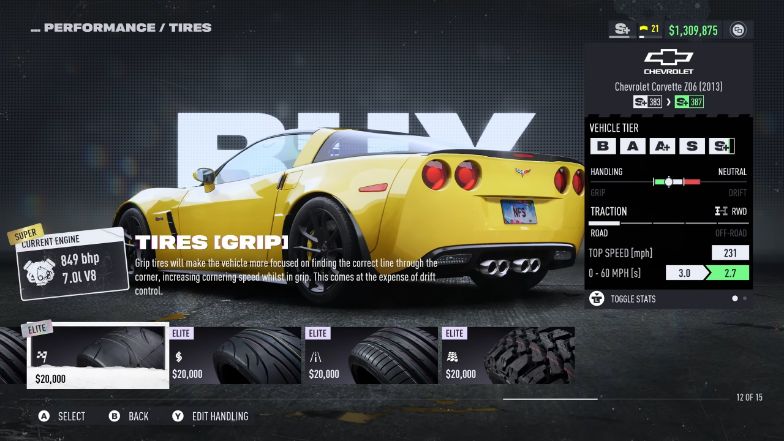
A complement to the suspension upgrades, tire upgrades have 5 different types per tier, namely: Neutral Tires, Grip Tires, Drift Tires, Road Tires, and Off-Road Tires.
Just like the Off-Road Suspension upgrades, the Off-Road Tires would be mainly used to lower a car’s performance rating at the cost of a more wayward-handling car, especially in the tarmac sections of a track. Otherwise, you can completely ignore them.
In a way, Neutral Tires could also be used as a min-maxing upgrade as they provide minimal performance rating gains but can increase a car’s grip by quite a bit, but it really comes down to the three other options.
With Grip Tires, you can set the handling slider a bit more biased towards the grip section. This increases your cornering speed while gripping a turn but also innately increases traction on tarmac roads.
Drift Tires are pretty much the opposite of Grip Tires as they set the handling slider a bit more biased toward the drift section. This makes drifting a lot easier as it makes the car a bit more prone to slide, although this can definitely be overlooked with other cars.
Older cars like the 1990 Ford Mustang Foxbody and cars with pretty skinny tires like the 2022 Nissan Prototype Z can opt to just leave their tires stock and they will drift much better than having Drift Tires equipped.
Road Tires, on the other hand, is much like the Neutral Tires upgrade, just much better in everything that it does. It provides better acceleration (especially on tarmac roads) but it does bump up the performance rating by quite a bit so if you are looking for just a minimal bump, you may just want to stick to the Neutral Tires.
Gearbox
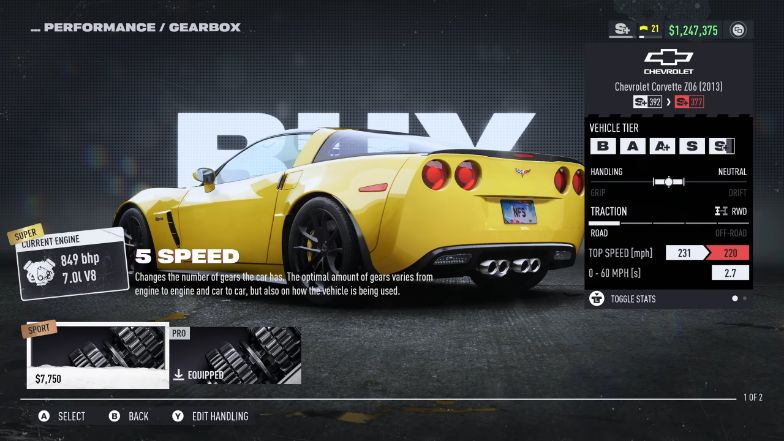
Definitely one of the more important performance upgrades in Need For Speed Unbound, the Gearbox upgrades are an interesting one.
Each car will have its own set of gears to choose from ranging from a 1 Speed all the way up to an 8 Speed gearbox. The number of gears will also correlate to how fast your top speed is.
At times, it might be a boon to switch to a gearbox with lesser gears as it will significantly decrease the top speed and performance rating, but it will keep its acceleration which would make it an amazing car for either a lower class or a track with tight corners.
Experiment with how fast your car can reach its top speed and decide whether that extra gear is worth spending money and performance points on or if you could go stock or a lower number of gears to get to your preferred top speed faster.
Auxiliary Upgrades

Auxiliary performance parts are additional performance parts that can help your car gain slight advantages over rival cars, and in the case of single-player, it could also get you a leg up on the cops.
Since we will be looking at how to get your car as fast as possible instead of just escaping the cops, we will be focusing on the auxiliary Nitrous upgrades, namely: Nitrous Grip, Nitrous Drift, Nitrous Jump, Nitrous Near Miss, and Nitrous Draft.
We can skip on getting Nitrous Jump and Nitrous Near Miss as these auxiliary mods are just too situational to be useful.
The usual two auxiliary mods that you can get are the Nitrous Grip and Nitrous Drift ones combined as it will guarantee that whichever type of turn you take a corner, you will get an increased amount of burst nitrous.
However, there is also a case to be made to swap out your one cornering auxiliary mod with the Nitrous Draft one as it would definitely help in having you keep up with your rivals with an otherwise underpowered car. This could also be useful on tracks that feature a lot of straights as it will keep you on your rivals’ tails with a ton of burst nitrous.
Handling Tuning
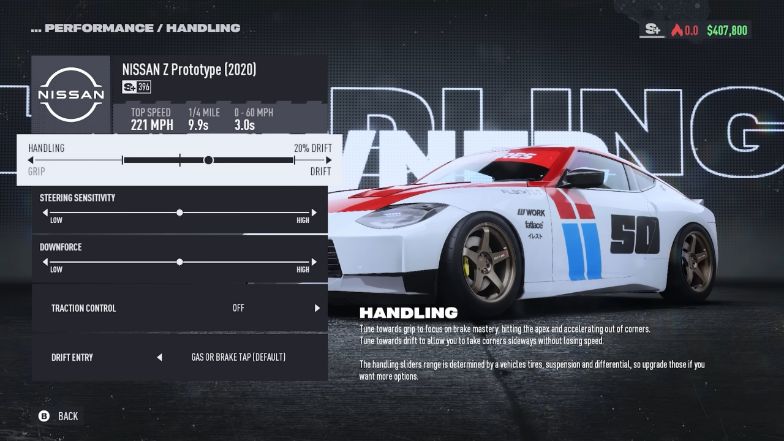
The Handling Tuning menu of Need For Speed Unbound is pretty much all the tuning you will be getting for your car, all condensed and streamlined into one menu. This menu is specific to each car so you will have to tune every car that you build in order to have it do what you want it to do.
It is very easy to understand, with only five sliders to toy with instead of the multitude of settings that can be found in a Forza Horizon or Gran Turismo game.
This menu can be found in both the garage menu as well as in the pause menu when you are out and about in the streets so you can do micro-adjustments when testing out your car.
Handling Slider
The first slider is the Handling slider which adjusts how your car’s handling would act. By putting it more to the left, it will be more grippy and handles corner with poise, while putting it more to the right will have it be more prone to slide and have the rear break away more easily.
It is not so much an understeer or oversteer slider, but whether or not you would want the car to just constantly grip a corner or have it break out to a drift upon corner entry or mid-corner.
While certain drivetrains will lend themselves to be more biased towards being grippy or drifty, this slider definitely helps in giving you a choice whether you want a more rigid handling model or a looser handling model.
The handling slider also affects your car’s performance rating, so if you are trying to min-max your car towards a certain class, then make sure to fiddle around with this option a bit to get the most out of your car.
Steering Sensitivity Slider
The steering sensitivity slider is a bit more self-explanatory. The more you put it onto the left, the less the car will be jittery, but it will also make it less responsive. The more you put it onto the right, the car will be more predictable, but it will make it a lot more stiff.
Finding a balance in this slider is definitely more of a preference, but it is recommended to have this higher the lower the performance rating of the car is, or if you are building a drift car, while having it lower once you reach around A+-class.

Downforce Slider
The downforce slider effectively acts like you are adjusting the car’s aerodynamics. The lower this slider is set, the faster your car’s top speed is by sacrificing cornering speed and stability, while heightening this slider will allow for better grip through corners at the cost of outright speed on the straights.
For drag and speed builds, this can definitely be set to the lowest as it can help you gain that little amount of speed you will be wanting. The same can be said for drift builds, as you would want the car to slide through a corner, and a lower downforce setting would help with that.
For track racing though, this can be set higher as it will help with cornering speed and stability immensely.
The downforce slider also affects your car’s performance rating, so if you are trying to min-max your car towards a certain class, then make sure to fiddle around with this option a bit to get the most out of your car.
Need For Speed Unbound’s performance rating seems to cater to top speed, so even though you are setting your car up to be better in the corners, it will dock some points from you, which is always a good thing as it gives you more options to tune your car with.
Traction Control
As the name suggests, this option allows you to turn on or off traction control for cars. By turning it on, your car will be more stable, but throttle control will be wrestled from you at times due to the system making sure not to get your wheels spinning excessively.
Turning it off will have the throttle control be all in your control. This option is definitely something to be turned off if you are experienced in racing games, but if you are new, you might want to leave this on.
This could also improve your launches so it may be a good option to have it on when building a drag build as well.
Drift Entry
The final option in the Handling Tuning menu, the Drift Entry option lets you customize how you want to initiate your drifts. These are Gas or Brake Tap, Gas Tap, Brake Tap, and Off.
Leaving this in the default option (Gas or Brake Tap) lets you have the option to initiate the drift by either just braking at speed or by double-tapping the gas so it initiates a slide.
The individual options will disable the option you did not pick, so if you want the classic Criterion Brake-to-Drift handling model, go for just Brake Tap. If you want Ghost’s implementation of the Brake-to-Drift handling model, go for the Gas Tap one.
Finally, there is Off, which forces you to either rip the handbrake in order to initiate a drift, or you would need to do a Scandinavian flick in order to start a slide. This setting is definitely recommended if you are going for a grip build so that you can not accidentally initiate a drift.
But again, this setting is pretty much a preference so experiment with whether you like easily-initiated drifts or powerslides that require a lot more finesse than usual.
Which Upgrades Should I Get First?

Each class will have its priorities when it comes to upgrades as cars from each class will need more of something than another thing to be clear from the rest of the pack.
In this section of the guide, we will be looking at the several classes available in Need For Speed Unbound and list down the parts that you should be upgrading in order to have an advantage.
There are a few upgrades that are needed in every class though as these do not add any performance rating to your car so they are pretty much free to put in while increasing your car’s capabilities.
- Differential: Elite Differential
- Auxiliary: Nitrous Grip and/or Nitrous Drift and/or Nitrous Draft
B-Class (100-159 Performance Rating)

In this class, power is everything. Cars are slow enough in this class not to require any upgrades to their Chassis, so it is all about the Engine Parts to increase our car’s power.
Engine Parts
If your car can afford it, putting in a Forced Induction kit (or an upgraded one for cars that already have one) can definitely help your power woes.
Otherwise, make your way down the engine parts tier of prices (ECU > Exhaust > Fuel System > Induction) and try to min-max your performance rating with those parts. You can leave the Nitrous alone for now as the Sport tier Nitrous is good enough for this class.
Chassis
These upgrades can be skipped entirely, however, you can put an Elite Neutral Suspension here to further widen the area of customization of the handling slider if you need your car to behave a certain way without having a performance rating cost.
Drivetrain
This is where it becomes a bit interesting. Since the top speed of B-class is somewhere along the lines of 130-140 MPH (210-225 KMH), you can opt to downgrade your gearbox or leave it stock to have lesser gears.
This will severely dampen your performance rating, but it will also have you accelerating much quicker and reaching your top speed far more often. Since most of the B-class races involve quite a lot of turns, the trade-off is definitely worth it.
Clutch upgrades can be ignored here for the time being as acceleration is not as important as top speed yet in this class.
A-Class (160-209 Performance Rating)

We are getting a bit faster, with speeds reaching 145-155 MPH (233-250 KMH), A-class is where the line between drift builds and grip builds start to coalesce. This then puts a bit mo importance on the handling of the car so we can introduce some Chassis upgrades.
However, A-class is still pretty much a class where power holds strong, we just need something to keep it on the road like better tires and suspension.
Engine Parts
Once again, we go for an upgrade or the installation of a Forced Induction kit first as they give out the most amount of power for the price. You can then work down the other engine parts as need be to squeeze out some more power from the engine.
We are looking for a car that has a rating of at least 160 MPH (258 KMH) on its Top Speed stat so that it can be effective on the straights while still having enough power to get out of corners quickly.
Nitrous can still be left alone as the burst nitrous system can still help us keep up with otherwise faster cars.
Chassis
Now that we are getting faster, and our car is producing more horsepower, we will need a better chassis to keep everything stable on the road.
Sport tier upgrades for the tires can definitely be considered, with Grip Tires being a priority if you are building a grip car. If you are confident enough, you can also go for Neutral Tires as they add the least amount of performance rating for a sizable amount of grip.
Drift cars can still be left with their stock tires since these tires can pretty much hold a drift rather well with no increase in performance rating.
As for suspension, you can still go for the Elite Neutral Suspension just for the increase in handling tuning. Road Suspension is not really needed in this class yet.
Brakes can also be ignored as the speeds are not yet high enough for us to consider braking power to be important.
Drivetrain
As our power increases, so does our top speed. Muscle cars that are equipped with 3-speed of 4-speed gearboxes should look at 5-speed gearboxes so that they can keep up with other racers on the straights.
However, cars with 6-speed or 7-speed can also look to reduce their amount of gears to further increase their acceleration. So long as your car’s Top Speed reads somewhere around 160 MPH (258 KMH), you are good.
Clutch upgrades can still be ignored in this class as the performance rating you gain from upgrading them is just too high for what they give.
A+-Class (210-269 Performance Rating)

By this class, grip cars are definitely the most superior of the builds, and drift cars are pretty much relegated to being show cars. With speeds easily reaching around 175-185 MPH (282-298 KMH), grip builds will just tend to corner faster than drift builds.
It is good to note though that this only applies to pure drift builds. If your car is around neutral handling or just around 20% onto grip handling, your car can still be viable and it can slide around the competition with ease.
Engine Parts
By this class, some cars will already be topping out with their stock engines, so engine swaps are definitely something to watch out for if your car’s engine is already reaching its peak powerband.
Otherwise, just keep upgrading your engine parts, with Forced Induction always taking priority, until it reaches Elite. If you need more acceleration, definitely put in a Roots Supercharger or Dual Turbo Charger. If you need the top speed more, go for the Single Turbo Charger.
Nitrous can also be upgraded up a tier now just to keep our bases secured. We will want a good launch off the line, and a longer-held nitrous helps tremendously.
Chassis
With the speed of racing increasing, we will need better tires and suspension to help us keep to the road and corner better. Pro tier Road Suspension can now be considered when picking out a suspension upgrade instead of the usual Neutral Suspension.
As for tires, we can definitely look to the Pro or Super tier upgrades now, especially for Grip or Road Tires as this will help tremendously with grip turns.
Brakes can be upgraded to its Super tier if needed (this is especially needed for heavier and older cars due to their worse brakes) but otherwise, they can actually still be left stock if you need to squeeze out a better performance rating with your engine parts.
Drivetrain
By this class, you should be looking at a 6-speed gearbox for your car so that it can reach its top speed easily. If your car’s gears are long enough though, you can always opt for less. Just make sure that your car’s Top Speed stat is around the 190 MPH (305 KMH) range.
Pro or Super tier clutch upgrades can also be looked at in this class as a good launch can determine the outcome of a race rather early.
S-Class (270-329 Performance Rating)

S-class is pretty much the class where most B-class and A-class starting cars will start having a hard time catching up with the thoroughbred supercars and hypercars without an engine swap.
The top speeds for this class are pretty close to A+-class at around 180-200 MPH (290-322 KMH), the cars just reach them way quicker in this class than they did in A+-class so the sensation of speed is heightened by quite a lot.
Engine Parts
Most cars will be needing all Elite performance parts just to reach the limit of S-class, but just in case your car has not reached it yet, you can always start with Forced Induction and once again work your way down the tier list of engine parts so that you do not spend too much money for better parts.
Nitrous should also pretty much be at Elite at this class so that your launches are at your absolute best and you can reserve a lot more nitrous when racing.
Chassis
With speeds reaching 200 MPH (394 KMH), now is the time we take a look at the Elite tier of tires to keep us on the road. Suspension should also be at either the Super or Elite tier as we are pretty much hitting the limit of performance now.
As for brakes, Super or Elite tier brakes can be considered as we will be needing the braking power to slow down significantly for corners, especially now that we are reaching speeds of 200 MPH (394 KMH).
Drivetrain
With supercars making their way into this tier in their stock form, 7-speed gearboxes are not out of the norm, but 6-speed gearboxes are plenty viable still in this class, especially for sports cars and muscle cars alike.
Clutch upgrades can still be limited to its Super tier instead of Elite as I still think that their increase in the performance rating is too much for what they offer. However, if your car is struggling at the start of the race, you can definitely prioritize upgrading it to the Elite tier.
S+-Class (330-400+ Performance Rating)

This is the end of the line; this is pretty much what Need For Speed tuning was before the class system was implemented in the series: an absolute free-for-all when it came to performance parts.
Put in everything that is Elite on your car, swap its engine for a better one, and just buy everything that is best for your car. The sky is the limit in this tier.
Speeds in this tier reach 220 MPH (354 KMH) to a game-limiting 245 MPH (394 KMH), so you better have quick reflexes when traveling down the highway.
Just remember what kind of car you are building, whether it be a drift build or a grip build car, and go wild with everything else!
Final Thoughts

And that concludes our Need For Speed Unbound tuning guide. Tuning is a process and it is very much amplified in this game as it lets your stay with your car in a selected class for quite a while.
While not as nuanced as the tuning options of Forza Horizon 5 or Gran Turismo 7, Need For Speed unbound strikes a good balance between giving the players a preference on how they want to drive their cars and making said cars competitive against other rivals, may it be online or offline.
With how Need For Speed Unbound oozes personality and pushes you to customize your car to your liking, the options given here by Criterion is a step in the right direction for both the franchise and for arcade racers alike.

